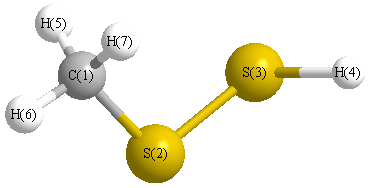Vibrational Frequencies calculated at B3LYP/CEP-31G
| Mode Number |
Symmetry |
Frequency
(cm-1) |
Scaled Frequency
(cm-1) |
IR Intensities
(km mol-1) |
Raman Act
(Å4/u) |
Dep P |
Dep U |
|---|
| 1 |
A |
3193 |
3092 |
25.89 |
56.05 |
0.75 |
0.86 |
| 2 |
A |
3173 |
3073 |
15.36 |
103.48 |
0.74 |
0.85 |
| 3 |
A |
3060 |
2963 |
29.72 |
184.04 |
0.02 |
0.04 |
| 4 |
A |
2446 |
2369 |
63.32 |
218.80 |
0.33 |
0.50 |
| 5 |
A |
1480 |
1433 |
14.08 |
14.29 |
0.66 |
0.79 |
| 6 |
A |
1461 |
1414 |
15.42 |
21.46 |
0.75 |
0.86 |
| 7 |
A |
1363 |
1320 |
4.26 |
1.06 |
0.74 |
0.85 |
| 8 |
A |
980 |
949 |
14.94 |
10.60 |
0.64 |
0.78 |
| 9 |
A |
978 |
947 |
9.44 |
15.38 |
0.75 |
0.86 |
| 10 |
A |
789 |
764 |
4.66 |
32.28 |
0.73 |
0.84 |
| 11 |
A |
639 |
619 |
1.39 |
28.50 |
0.34 |
0.51 |
| 12 |
A |
435 |
422 |
1.01 |
35.10 |
0.28 |
0.44 |
| 13 |
A |
237 |
230 |
29.89 |
34.21 |
0.75 |
0.86 |
| 14 |
A |
206 |
199 |
0.80 |
8.95 |
0.66 |
0.79 |
| 15 |
A |
148 |
143 |
1.32 |
0.59 |
0.74 |
0.85 |
Unscaled Zero Point Vibrational Energy (zpe) 10294.0 cm
-1
Scaled (by 0.9684) Zero Point Vibrational Energy (zpe) 9968.7 cm
-1
See section
III.C.1 List or set vibrational scaling factors
to change the scale factors used here.
See section
III.C.2
Calculate a vibrational scaling factor for a given set of molecules
to determine the least squares best scaling factor.
Charges, Dipole, Quadrupole and Polarizability
Charges from optimized geometry at B3LYP/CEP-31G
Charges (e)
| Number |
Element |
Mulliken |
CHELPG |
AIM |
ESP |
| 1 |
C |
-0.580 |
|
|
|
| 2 |
S |
0.004 |
|
|
|
| 3 |
S |
-0.089 |
|
|
|
| 4 |
H |
0.059 |
|
|
|
| 5 |
H |
0.212 |
|
|
|
| 6 |
H |
0.196 |
|
|
|
| 7 |
H |
0.199 |
|
|
|
Electric dipole moments
Electric dipole components in Debye
(What's a Debye? See section
VII.A.3)
| |
x |
y |
z |
Total |
| |
-1.390 |
1.610 |
1.353 |
2.521 |
| CHELPG |
|
|
|
|
| AIM |
|
|
|
|
| ESP |
|
|
|
|
Electric Quadrupole moment
Quadrupole components in D Å
| Primitive |
|---|
| | x | y | z |
|---|
| x |
-29.787 |
-0.898 |
2.609 |
| y |
-0.898 |
-34.366 |
0.525 |
| z |
2.609 |
0.525 |
-32.234 |
|
| Traceless |
|---|
| | x | y | z |
|---|
| x |
3.513 |
-0.898 |
2.609 |
| y |
-0.898 |
-3.355 |
0.525 |
| z |
2.609 |
0.525 |
-0.158 |
|
| Polar |
|---|
| 3z2-r2 | -0.316 |
|---|
| x2-y2 | 4.579 |
|---|
| xy | -0.898 |
|---|
| xz | 2.609 |
|---|
| yz | 0.525 |
|---|
|
Polarizabilities
Components of the polarizability tensor.
Units are
Å
3 (Angstrom cubed)
Change units.
| |
x |
y |
z |
| x |
10.112 |
0.819 |
0.209 |
| y |
0.819 |
5.464 |
0.052 |
| z |
0.209 |
0.052 |
4.005 |
<r2> (average value of r
2) Å
2
| <r2> |
75.345 |
| (<r2>)1/2 |
8.680 |
